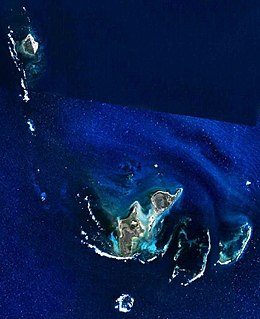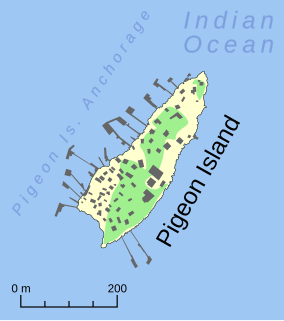
The Houtman Abrolhos is a chain of 122 islands, and associated coral reefs, in the Indian Ocean off the west coast of Australia. Nominally located at 28°43′S113°47′E, it lies about eighty kilometres (50 mi) west of Geraldton, Western Australia. It is the southernmost true coral reef in the Indian Ocean, and one of the highest latitude reef systems in the world. It is one of the world's most important seabird breeding sites, and is the centre of Western Australia's largest single-species fishery, the western rock lobster fishery. It has a small seasonal population of fishermen, and a limited number of tourists are permitted for day trips, but most of the land area is off limits as conservation habitat. It is well known as the site of numerous shipwrecks, the most famous being Dutch ships Batavia, which was wrecked in 1629, and Zeewijk, wrecked in 1727.
The mulga dragon is a species of agamid lizard found in Western Australia. The species is up to 250 mm long, the length from snout to vent is 95 mm, with a long, slender tail that ends abruptly. The patterning over the legs and body is grey and brownish streaks. This provides an excellent camouflage on mulga trees, its usual habitat, it is also found beneath mulga leaf litter. Diporiphora amphiboluroides generally remains motionless and unobserved, this allows it to operate as an ambush predator and elude animals that would prey on it.

Pogona is a genus of reptiles containing six lizard species which are often known by the common name bearded dragons. The name "bearded dragon" refers to the "beard" of the dragon, the underside of the throat, which can turn black and puff out for a number of reasons, most often as a result of stress, or if they feel threatened. They are a semi-arboreal species, spending significant amounts of time on branches, in bushes, and near human habitation. Pogona species bask on rocks and exposed branches in the mornings and afternoons. They are found throughout much of Australia in a wide range of habitats such as deserts, shrublands and Eucalyptus woodlands.

The central bearded dragon, also known as the inland bearded dragon, is a species of agamid lizard found in a wide range of arid to semiarid regions of eastern and central Australia. This species is the most popularly kept reptile pet, and exhibited in zoos.

The eastern bearded dragon, also known as common bearded dragon or simply bearded lizard, is an agamid lizard found in wooded parts of Australia. It is one of a group of species known commonly as bearded dragons. Other common names for this species include Jew lizard and frilly lizard, the latter being a confusion between this and another dragon, the frill-necked lizard. This species was originally described in 1829 by Georges Cuvier, who named it Amphibolurus barbatus.

Rankin's dragon is a species of Australian agamid lizard. It may also be called the pygmy bearded dragon.

The western bearded dragon is a species of agamid lizard from a group commonly known as bearded dragons, and is found on the southwest coast and interior of Western Australia. This taxonomic name includes the subspecies; Pogona minor minor which is widespread across West Australia between the Pilbara and the south coast,. The Abrolhos dwarf bearded dragon, which is confined to the Wallabi Group of islands. There is another subspecies, Mitchell's Bearded Dragon which lives in tropical woodlands of the Kimberley area of West Australia.

The pygmy python, also known as the anthill python, is a species of snake found in Western Australia. Their common names refer to the fact that they are the smallest member of the family Pythonidae and are often found in termite mounds. The specific epithet is derived from the state capital, Perth, despite the fact that this place is not within the range of the species. No subspecies are currently recognized.

The Wallabi Group is the northernmost group of islands in the Houtman Abrolhos off the western coast of Western Australia. Nominally located at 28°28′S113°42′E, it is 58 kilometres from the Australian mainland, and about 9 kilometres from the Easter Group.

North Island is the northernmost island in the Houtman Abrolhos, a coral reef archipelago in the Indian Ocean off the coast of Mid West Western Australia. Located about 14 km (9 mi) from the nearest island group, it is one of the largest islands in the Houtman Abrolhos, and one of the few to support dune systems. It has relatively diverse flora dominated by chenopod shrubs and fauna that includes the introduced tammar wallaby, around seven species of reptile, and about 15 resident bird species.
The Abrolhos painted buttonquail is a subspecies of the painted buttonquail endemic to the Houtman Abrolhos. It is common on North Island, and also occurs on other islands of the Wallabi Group, namely East Wallabi, West Wallabi, Seagull and Pigeon Islands.

Morelia imbricata is a large snake found in southern regions of Western Australia and western South Australia. A member of the python family, it is commonly known as the Southwest carpet python.

Pigeon Island is a small island located need the middle of the Wallabi Group of the Houtman Abrolhos, an archipelago off the coast of Western Australia. It is almost entirely given over to western rock lobster fishers' camps, and as a result is far more disturbed than most other islands in the archipelago. A nearby island also seasonally populated by fishers is named Little Pigeon Island, hence Pigeon Island is sometimes referred to as "Big Pigeon Island".
Shag Rock is a small rocky island in the Wallabi Group of the Houtman Abrolhos.

East Wallabi Island is an island in the Wallabi Group of the Houtman Abrolhos, located in the Indian Ocean off the west coast of mainland Australia.
West Wallabi Island is an island in the Wallabi Group of the Houtman Abrolhos, in the Indian Ocean off the west coast of mainland Australia.

The Amphibolurinae are a subfamily of reptiles in the family Agamidae. Members of this subfamily are found in Australia and New Guinea, although one species, the Chinese water dragon, is found in Southeast Asia.

Beacon Island, also known as Batavia's graveyard, is an island on the eastern side of the Wallabi Group at the northern end of the Houtman Abrolhos, in the Indian Ocean, off the coast of Western Australia.













